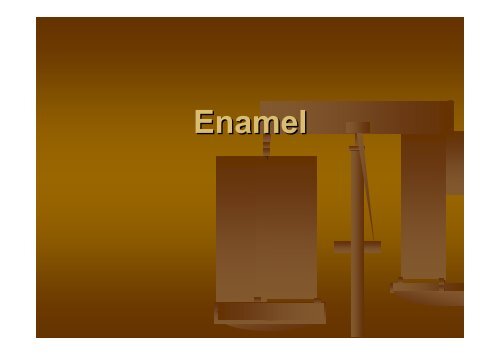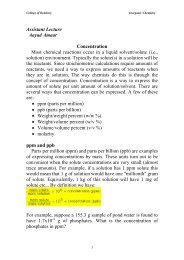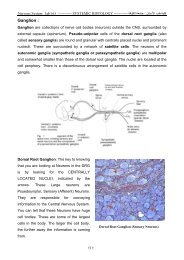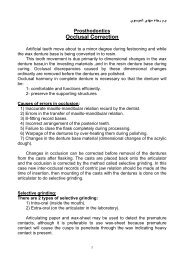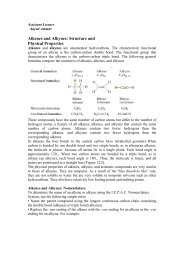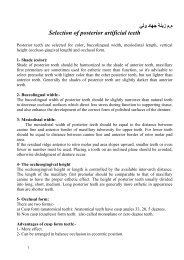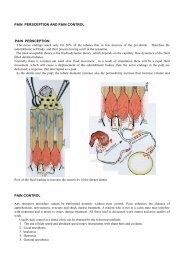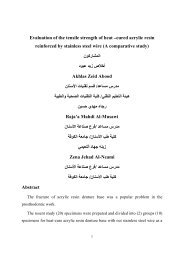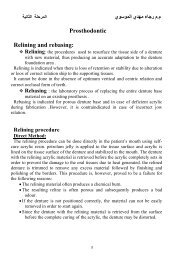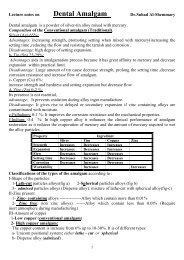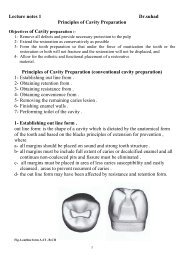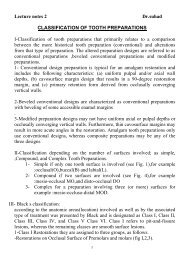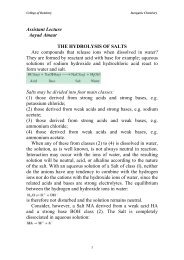lec.6 Enamel
lec.6 Enamel
lec.6 Enamel
Create successful ePaper yourself
Turn your PDF publications into a flip-book with our unique Google optimized e-Paper software.
It s the hardest tissue in the body, epithelially<br />
derived from the ectoderm layer, it is protective<br />
layer of the tooth. Ameloblasts are the cells<br />
which are responsible for it's formation, derived<br />
from the inner enamel epithelial cells,<br />
ameloblasts are lost as the tooth erupted in to<br />
the oral cavity & hence the enamel is non vital<br />
so it can't renew itself.
Physical properties of E :
1.E is the hardest tissue in the human body<br />
, it's also brittle & subject to fracture<br />
specially if the underlying dentin is<br />
carious, causing a weak foundation.
2. E is very hard because it compose of 96%<br />
mineral (inorganic) in a form of<br />
hydroxyapitite crystal (which is crystalline<br />
calcium phosphate Ca10(Po)6(OH)2 &<br />
4%organic & water. The organic matrix of<br />
E is made from noncollagenous proteins &<br />
contain several protein & enzymes . 90%<br />
of enamel protein is amelogenins & the<br />
remaining 10% consist of enamelin &<br />
ameloblastin
3. E is white to grayish white but it's<br />
appear slightly yellow because it is<br />
translucent & the underlying dentin is<br />
yellowish, give the yellow color to E.<br />
4. E is ranges in thickness from a knife edge<br />
at it's cervical margin to about 2-5mm 2<br />
maximum thickness over the occlusal or<br />
incisal surface
5.E is semipermeable, , it can permit exchange ions<br />
& molecules specially if it is newly erupted tooth.<br />
Florid can penetrate enamel easily in newly<br />
formed & be less permeability in adult one.<br />
6.E may be altered by etching with dilute acids<br />
such as citric acid (E has a property of acid<br />
solubility) etching of the E can be used in the<br />
anterior filling & to allow adherence of a plastic<br />
sealant.
Structure of enamel
The basic units of E are the rods (prisms) & interrod E<br />
(interprismatic<br />
substance).
The number of E rods range from 5 million in<br />
lower lateral incisors to 12 million in upper first<br />
molar.<br />
The length of the rods is greater than the<br />
thickness of E because of the oblique direction &<br />
wavy course of rods.<br />
Rods located in the cusps are longer than that in<br />
the cervical areas.<br />
Diameter of rods increase from the DEJ<br />
(dentinoenamel<br />
junction ) toward the surface of<br />
the enamel at ratio about 1:2.
Rods in cross section appear hexagonal<br />
sometimes they appear round or oval or fish<br />
scales due to different angulations during the<br />
section.
A common pattern of prism is a key hole<br />
in longitudinal section the bodies or heads<br />
of one row of rods & tails of adjacent row<br />
represent the interrod substance , the<br />
bodies are nearer the occlusal & incisal<br />
surface, whereas the tails point cervically.<br />
Each rod formed by 4 ameloblast cells.
Rod sheath :<br />
It is represent the organic matrix of the E & it is incomplete<br />
envelop surrounding the rod.<br />
Direction of rods<br />
In general rods run in a perpendicular direction to the<br />
surface of the dentin with slight inclination toward the<br />
cusps, near the cusp tip they run more vertically & in<br />
the cervical enamel run horizontally.<br />
In the cusps of teeth the rods appear twisted around each<br />
other in a complex arrangement called gnarled enamel.
Hunter Schreger bands:<br />
These are an optical phenomena produce by<br />
changes in the direction of rods. These<br />
bands appear as dark & light alternating<br />
zones clearly seen in longitudinal ground<br />
section & they are found in the inner two<br />
third of the E.
All the E rods are deposited in daily appositional<br />
rate or incremental form of 4micrometer such<br />
increments are noticeable as a brownish bands<br />
in ground section of E. in transverse ground<br />
section these lines appear as concentric circles.<br />
In longitudinal section they appear as dark lines<br />
surround the crown they run obliquely. The<br />
growth lines also appear in the surface of the E<br />
as aridges (wave like grooves) as external<br />
manifestation of stria of Retzius known as<br />
perikymata.
Neonatal lines : is an enlarged stria of Retzius<br />
reflected the great physiological changes<br />
occurring before & after birth.<br />
E lamellae: They are visible cracks of varying<br />
depths extend from the surface of E toward the<br />
DEJ they consist of linear, longitudinally oriented<br />
defects filled with organic material. best<br />
demonstrated in ground section. E lamella<br />
represent a pathway for initiating caries in E.
E tufts:<br />
These are tuft like contain organic material<br />
arise from DEJ up to (1/5<br />
1/3) of E<br />
thickness. They contain greater<br />
concentration of E protein's than the rest<br />
of E & they believed to occur<br />
developmentally due to changes in the<br />
direction of rods.
E spindles<br />
They are only the mesenchymal structure in<br />
the E extending from the odontoblast<br />
process through the E . they appear dark<br />
color in ground section.
Surface structures of E
1.perikymata : it is a shallow grooves on E surface believed<br />
to be manifestation of striae of Retzius.<br />
2. pellicle: as the tooth erupted, it is covered by pellicle<br />
consisting of debris from the E organ that is lost rapidly,<br />
then the salivary pellicle deposit on the tooth surface<br />
which can removed by mechanical cleaning.<br />
3.rods ends: they appear as pits or depression on the<br />
surface of the tooth & these disappear by the<br />
mastication.
4. rodless E: E without prism (rod) , the<br />
mineralization of this type E is higher than the<br />
remaining E due to the lose of rod so the crystal<br />
are roughly arranged. It is 30 micrometer in<br />
thickness occur in 70% of permanent teeth & in<br />
all deciduous teeth in cusp tip & cervical area.<br />
5. Primary E cuticle : It is delicate membrane<br />
cover the entire crown of newly erupted tooth<br />
secreted by ameloblasts & soon removed by<br />
mastication .
This document was created with Win2PDF available at http://www.win2pdf.com.<br />
The unregistered version of Win2PDF is for evaluation or non-commercial use only.<br />
This page will not be added after purchasing Win2PDF.


